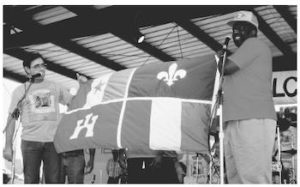
*On this date in 1441, Creole communities of the Americas and the Caribbean are celebrated. This community evolved primarily because of the Middle Passage.
In regions that were formerly colonies of Spain, the Spanish word criollo (implying "native" or "local") historically denoted a class in the colonial caste system, comprising people born in the colonies but of totally or at least largely Spanish descent. The word came to refer to things distinctive of the region, as it is used today, in expressions such as "Comida Criolla" ("country" food from the area).
In the latter settlement period in Latin America, the Treaty of Tordesillas was signed in 1494. The Spanish called La Colonia; the Bourbon Spanish Crown preferred Spanish-born Peninsulares (literally "born in the Iberian Peninsula") over Criollos for the top military, administrative, and religious offices due to the former mismanagement of the colonies in a previous Habsburg era. The word criollo is the origin and cognate of the French word creole. Starting in the 16th century in (what was) Spanish America, the racially-based caste system was in force throughout their colonies in the Americas. The Asiento slave system was sanctioned in 1518.
By the 19th century, this discrimination, an example of the American Revolution, and the Enlightenment ideals eventually led the Spanish-American Criollo elite to rebel against Spanish rule. With the support of the lower classes, they engaged Spain in the Spanish-American wars of independence (1810–1826), which ended with the break-up of the former Spanish Empire in the Americas into several independent republics.
In many parts of the Southern Caribbean, the term Creole people refers to the mixed-race descendants of white Europeans and Africans born on the islands or brought there as slaves. Over time, there was intermarriage with residents from Asia as well. They eventually formed a common culture based on their experience of living together in countries colonized by the white French, Spanish, Dutch, and British.
A Creole person from the Caribbean could have French, Spanish, Portuguese, British, and/or Dutch ancestry, mixed with sub-Saharan Africa, and sometimes mixed with Native Indigenous people of the Americas. As workers from Asia entered the Caribbean, non-white Creole people intermarried with Arabs, Indians, Chinese, Javanese, and Hmong. The latter combinations were especially common in Guadeloupe. Creole language, foods, and cultures are the result of these influences.